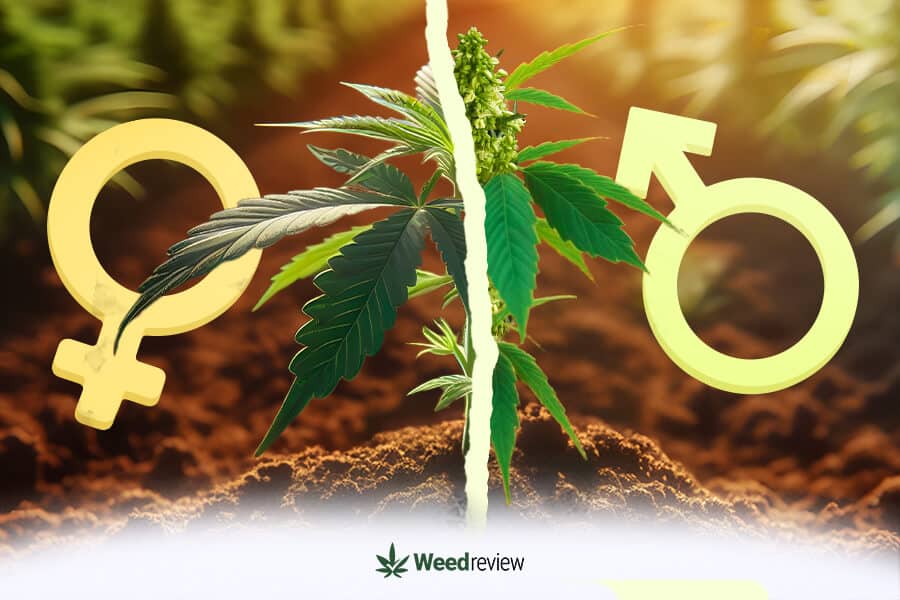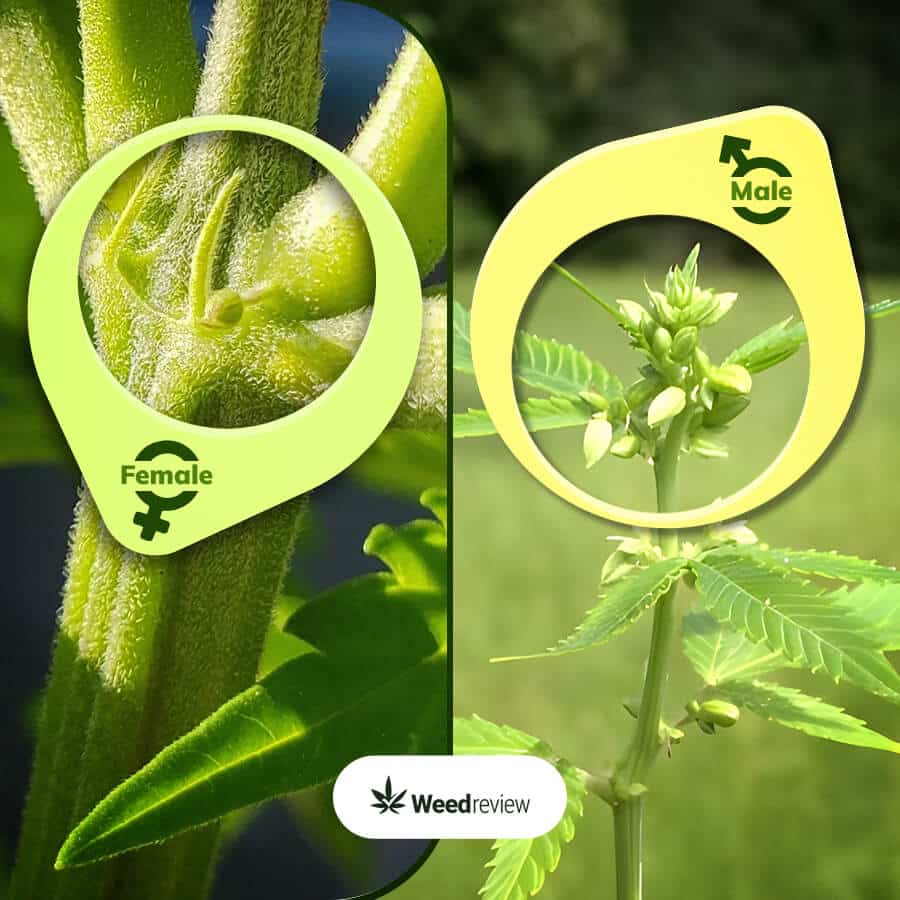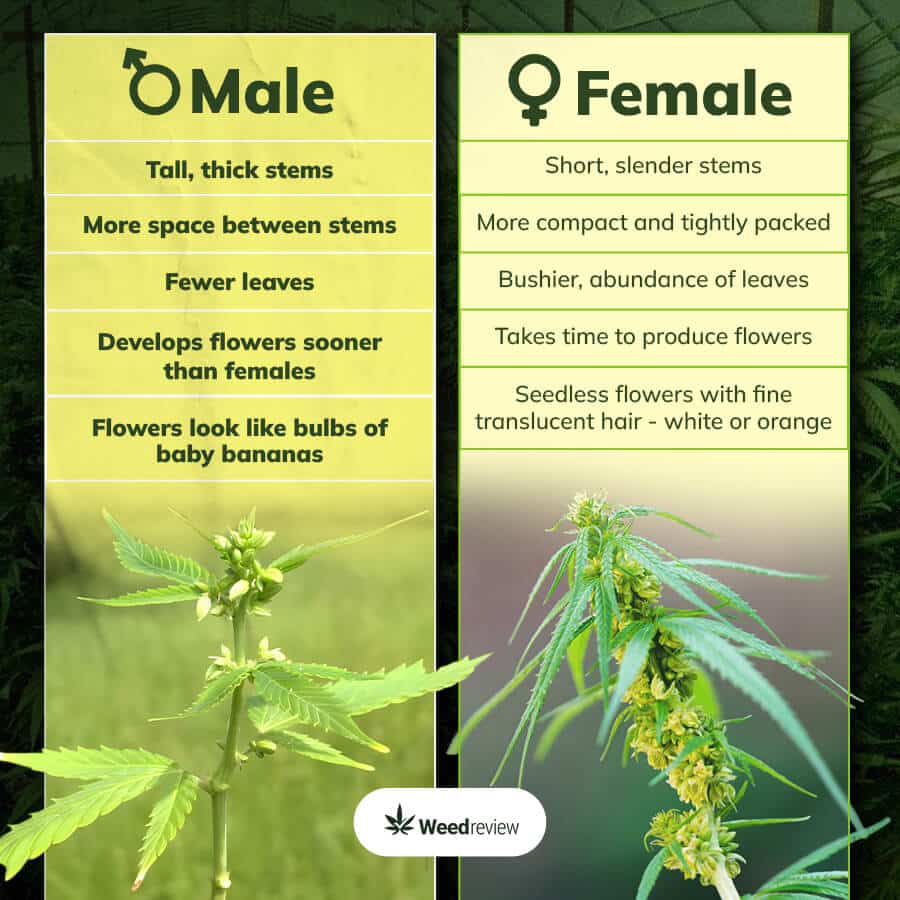
How to Identify Male & Female Cannabis Plants: A Detailed Guide

Table of Contents
Marijuana is a dioecious plant – it comes in both male and female forms. Each gender plays a unique role in the cultivation process, especially if your goal is to produce buds. Female plants are the ones that develop seedless buds rich in THC – used for medicinal and recreational purposes. On the other hand, male plants are mainly used for breeding and producing new strains.
Understanding the gender of your cannabis plants is crucial because it directly influences the outcome of your harvest.
In this article, we will guide you through the process of identifying male and female cannabis plants. We’ll start by explaining how to spot the early signs of gender through pre-flowers. Then, we dive into the distinct characteristics of male and female plants. We’ll also discuss what to do with male plants in your garden, how to handle hermaphrodite plants, and offer insights into cannabis seeds to ensure female plants.
Sexing marijuana plants: Cannabis pre-flowers tell the gender
Pre-flowers are small structures that appear at the nodes of the plant (where branches and leaves extend from the main stem) and can be seen before the plant fully enters the flowering stage. These pre-flowers are like early indicators of whether you have a male or a female plant.
Typically, pre-flowers start to develop about four to six weeks into the plant’s growth, but it can vary depending on the strain and environmental conditions. It’s a bit of a waiting game and requires a keen eye, as these pre-flowers are small.
Identifying them accurately is crucial, as it helps you decide which plants to keep and which to remove, depending on your cultivation goals.
What do male pre-flowers look like?

Male cannabis pre-flowers are small and typically develop as tiny round pollen sacs at the plant’s nodes (where branches or leaves meet the main stalk). These pollen sacs – which look like tiny balls – eventually grow into clusters that may resemble bunches of bananas. When they burst, they release pollen necessary for seed production in female plants.
What do female pre-flowers look like?
Female pre-flowers develop from what is known as a calyx; it has a tear-like shape with a pointed tip. The defining characteristic of female pre-flowers is the emergence of small, translucent white hairs from the calyx. These hairs, known as stigmas, are part of the undeveloped female flower and are essential for capturing pollen.
Differences between mature male and female marijuana plants

While the early identification of cannabis gender relies on the appearance of pre-flowers, several other differences become clear as the plants mature.
- Male plants tend to be taller with longer internodal spacing (the gaps between branches on the main stem). They also have fewer fan leaves and thicker stalks; this is because male plants grow longer than females and must support the weight.
- In contrast, female plants generally grow shorter and bushier with tighter internodal spacing. You will find more leaves – especially at the top. Additionally, the calyx on female plants is typically larger and has white hair, while on male plants, it is smaller and hairless.
When can you identify the gender of cannabis plants?
Pre-flowers develop about 3-6 weeks after germination. Male pre-flowers as appear as early as 3-4 weeks, while female pre-flowers tend to develop a bit later, around 4-6 weeks.
That said, the timing can vary depending on the strain and environmental conditions.
What should you do with the male flowers in your garden?
Male cannabis plants are typically removed from the garden if the goal is to grow sinsemilla (seedless cannabis). This is because male plants can pollinate female plants, leading to seeded buds which are less potent and desirable.
However, male plants have their uses too. They are essential for breeding new cannabis strains and can also be used for hemp fibre production or cannabinoid extraction.
What if your plant is hermaphrodite?
Hermaphroditic cannabis plants possess both male and female reproductive parts. You will know your plant is hermaphrodite if you see male and female pre-flowers appear on the stalk.
This can lead to self-pollination and seed production, which is usually undesirable. If you find a hermaphrodite plant, treat it as a male. It is generally recommended to remove it to prevent it from pollinating female plants and affecting the quality of your crop.
Cannabis gender identification: What else do you need to know?
Next, we dive into advanced strategies for pinpointing and steering the gender of cannabis plants, key for growers looking to fine-tune their crops for better yields.
Can you tell if cannabis seeds are male or female?
It’s not possible to determine the gender of a cannabis plant from its seed. You must wait until the seeds have sprouted and the plant has reached the pre-flowering phase.
However, feminised seeds are bred to produce female plants only. These seeds are created by inducing a female plant to produce pollen and then using this pollen to fertilize another female plant, resulting in seeds that are almost always female.
How to get more female plants from regular seeds?
You can create a stable, stress-free environment to ensure female plants. Some growers also employ techniques like adjusting light cycles or using certain supplements, but these methods are not foolproof.
Common methods include:
- Lighting: Use an 18-6 hour day-night photoperiod, reducing to about 14.5 hours to increase female plant chances.
- Blue light: Use blue spectrum lighting – preferably from a metal halide light – during vegetation to promote female development.
- Nitrogen & potassium levels: Increase nitrogen slightly while reducing potassium during the vegetative phase to promote female tendencies.
- Humidity and moisture: Maintain high humidity (70-80% RH) for young plants and consistent moisture in the growing medium; gradually reduce humidity as plants enter the flowering stage.
- Avoid stress: Reduce environmental stress and maintain stable growing conditions to reduce the likelihood of male plant development.
How do genetics, environment, and stress affect the gender of marijuana?
While genetics determine the potential for a plant to be male or female, environmental factors like temperature, light, and nutrition can impact gender expression.
For instance, subjecting plants to the flowering light cycle prematurely, before they have developed pre-flowers, can create stress. This sudden change disrupts their growth cycle and can lead to hermaphroditism. Other forms of stress that might affect gender expression include physical damage, nutrient imbalances, and water stress (either too much or too little). Extreme temperatures, especially excessive heat, can also stress cannabis plants, potentially leading to hermaphroditism.
Each of these stressors can push the plant to develop characteristics of both genders as a survival mechanism.
Common myths about cannabis gender identification
Can male flowers get you high? Is it possible to tell the gender of cannabis just from their seeds? Common misconceptions and myths around sexing cannabis plants are addressed below:
- Only female plants are useful: While it’s true that female cannabis plants are primarily valued for their bud production, male plants have their uses too. They are essential for breeding new strains and can also be used for hemp fibre and cannabinoid extraction.
- Male plants cannot get you high: Although male cannabis plants have lower THC levels compared to females, they still contain cannabinoids and can produce mild psychoactive effects.
- You can determine the gender of the seed: It’s a common myth that you can tell the gender of a cannabis plant from its seed. Unless buying feminised seeds, in reality, the gender can only be determined after the plant starts developing.
- Stress always produces hermaphrodites: While stress can lead to the development of hermaphrodite plants, it’s not always the case. The genetic stability of the plant also plays a crucial role.
- Feminised seeds produce only female plants: While feminized seeds are bred to produce female plants, there’s still a small chance they can develop into hermaphrodite plants under certain conditions.
Conclusion
In summary, male plants develop small, round pollen sacs at the nodes, while female plants show two white hairs emerging from a calyx. Remember, it’s impossible to determine the plant’s gender from its seeds themselves; this becomes evident only as the plant matures.
Feminized seeds are a popular choice for those seeking to grow predominantly female plants, but there’s always a small chance of hermaphroditism, especially under stress. Creating a stable, stress-free growing environment and paying attention to factors like light cycles and nutrition can increase the chances of female plants from regular seeds.
Understanding the role of male, female, and hermaphroditic plants in your cannabis garden is essential for achieving your cultivation goals, whether they be high-quality buds, breeding new strains, or producing fibres.



